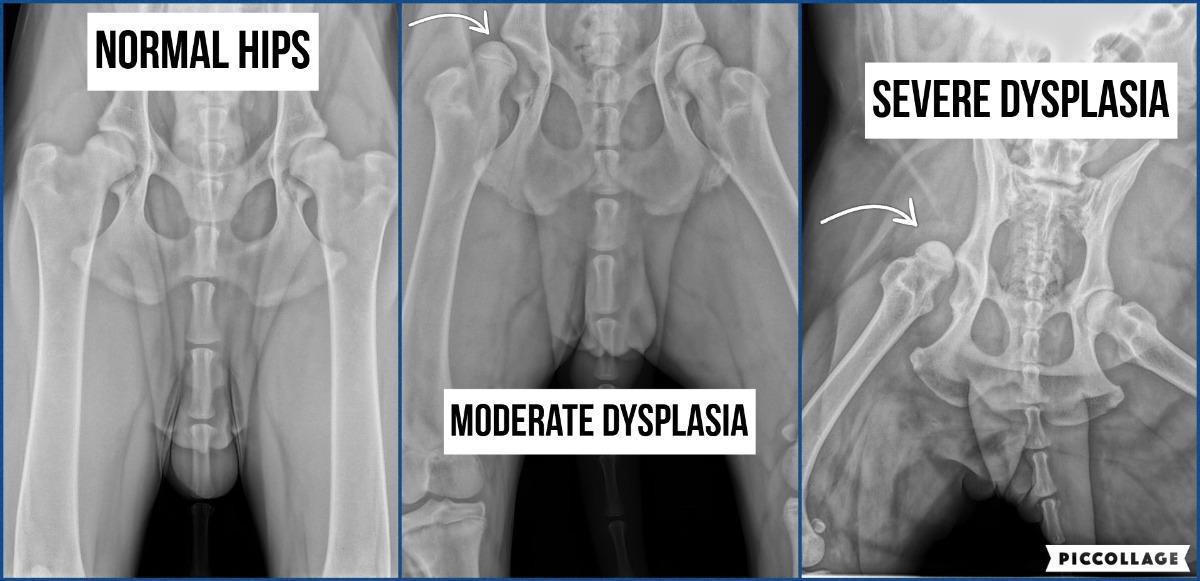Hip Dysplasia in Dogs

- posted: Oct. 17, 2020
Hip Dysplasia in Dogs
Hip dysplasia is a common orthopedic problem in dogs. But what is it, what are the risk factors and how is it treated? Read on for more information!
Hip dysplasia occurs most commonly in large or giant breed dogs such as Labradors, German Shepherds and Saint Bernards, though any dog may be affected. Dysplasia occurs when the hip socket is too shallow to hold the round end or “ball” of the femur snugly. Over time, the cartilage wears away from abnormal movement of the femur against the socket. This causes pain and lameness as bone bumps against bone when the dog walks.
What causes hip dysplasia? Hip dysplasia has both hereditary and environmental factors. Some dogs are genetically predisposed to developing hip dysplasia which is why screening breeding dogs is so important. But obesity, poor nutrition, too much or too little exercise and factors that affect proper skeletal growth such as early spay/neuter or rapid skeletal growth due to an improper diet are other contributing factors that can magnify the inherited genetics.
Tips for reducing the chance of developing hip dysplasia: Feed your dog a good diet and one formulated for large breed dogs, make sure your dog maintains proper weight and provide a controlled exercise protocol (avoid long periods of high impact activity in puppies and at-risk breeds and limit time on stairs in pups under 12 weeks of age). Normal play in a yard or carpeted area and short walks are fine. Spaying and neutering large breed dogs before 6 months of age is no longer recommended. Large and giant breed dogs (dogs who will be over 50lbs as adults) should be allowed to fully mature before being spayed or neutered as this may reduce some factors that cause hip dysplasia.
Hip dysplasia is diagnosed by taking an x-ray or radiograph of the hips. Dogs may need to be sedated to get a good x-ray picture. Large breed dogs who are going to be used for breeding should ideally be screened for hip dysplasia before breeding. This also involves taking x-rays of the hips under sedation. Hip x-rays are then sent to either the Orthopedic Foundation for Animals (OFA) or to PennHip for evaluation. PennHip x-rays are taken by a certified veterinarian and can be used to screen dogs as young as 16 weeks of age and is thought to be more accurate than OFA radiographs which are not diagnostic in dogs under two years of age.
How is hip dysplasia treated? Depending on the severity of symptoms and the degree of deformity of the joint, dogs may be managed with joint supplements and pain medications for mild cases. Severe cases usually require surgery. A few different surgical procedures can be done to correct hip dysplasia and reduce pain. Removing the ball of the femur in a femoral head ostectomy (FHO), replacing the hip with a false joint or modifying the hip joint and pelvis in a procedure called a triple pelvic osteotomy or TPO are all potential surgical options.
If your dog has trouble getting up, limps when walking or has an abnormal gait, “hops” like a bunny when running or shows other signs of discomfort, have hm or her checked for hip dysplasia, especially if you have a commonly affected breed. If diagnosed early, you can do things to reduce symptoms, keep you pet at a healthy weight and better plan for surgery down the line if needed.
This blog brought to you by the Patton Veterinary Hospital serving Red Lion, York and the surrounding communities.
https://veterinarypartner.vin.com/default.aspx?pid=19239&id=4952203
https://www.akc.org/expert-advice/health/hip-dysplasia-in-dogs/
Location
Patton Veterinary Hospital
425 E Broadway
Red Lion, PA 17356
